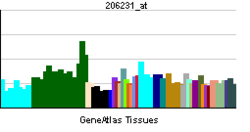KCNN1
| KCNN1 | ||||||
|---|---|---|---|---|---|---|
| Identifiers | ||||||
| Aliases | KCNN1, KCa2.1, SK1, SKCA1, hSK1, potassium calcium-activated channel subfamily N member 1 | |||||
| External IDs | MGI: 1933993 HomoloGene: 37595 GeneCards: KCNN1 | |||||
| Targeted by Drug | ||||||
| bicuculline, tetraethylammonium, tubocurarine[1] | ||||||
| RNA expression pattern | ||||||
 | ||||||
| More reference expression data | ||||||
| Orthologs | ||||||
| Species | Human | Mouse | ||||
| Entrez | ||||||
| Ensembl | ||||||
| UniProt | ||||||
| RefSeq (mRNA) | ||||||
| RefSeq (protein) | ||||||
| Location (UCSC) | Chr 19: 17.95 – 18 Mb | Chr 8: 70.84 – 70.86 Mb | ||||
| PubMed search | [2] | [3] | ||||
| Wikidata | ||||||
| View/Edit Human | View/Edit Mouse |
Potassium intermediate/small conductance calcium-activated channel, subfamily N, member 1 , also known as KCNN1 is a human gene encoding the KCa2.1 protein.[4]
Action potentials in vertebrate neurons are followed by an afterhyperpolarization (AHP) that may persist for several seconds and may have profound consequences for the firing pattern of the neuron. Each component of the AHP is kinetically distinct and is mediated by different calcium-activated potassium channels. The protein encoded by this gene is activated before membrane hyperpolarization and is thought to regulate neuronal excitability by contributing to the slow component of synaptic AHP. The KCa2.1 protein is an integral membrane protein that forms a voltage-independent calcium-activated channel with three other calmodulin-binding subunits. The KCNN1 gene is a member of the KCNN family of potassium channel genes.[4]
See also
References
- ↑ "Drugs that physically interact with Small conductance calcium-activated potassium channel protein 1 view/edit references on wikidata".
- ↑ "Human PubMed Reference:".
- ↑ "Mouse PubMed Reference:".
- 1 2 "Entrez Gene: KCNN1 potassium intermediate/small conductance calcium-activated channel, subfamily N, member 1".
Further reading
- Wei AD, Gutman GA, Aldrich R, et al. (2006). "International Union of Pharmacology. LII. Nomenclature and molecular relationships of calcium-activated potassium channels". Pharmacol. Rev. 57 (4): 463–72. doi:10.1124/pr.57.4.9. PMID 16382103.
- Köhler M, Hirschberg B, Bond CT, et al. (1996). "Small-conductance, calcium-activated potassium channels from mammalian brain". Science. 273 (5282): 1709–14. doi:10.1126/science.273.5282.1709. PMID 8781233.
- Litt M, LaMorticella D, Bond CT, Adelman JP (1999). "Gene structure and chromosome mapping of the human small-conductance calcium-activated potassium channel SK1 gene (KCNN1)". Cytogenet. Cell Genet. 86 (1): 70–3. doi:10.1159/000015415. PMID 10516439.
- Shah M, Haylett DG (2000). "The pharmacology of hSK1 Ca2+-activated K+ channels expressed in mammalian cell lines". Br. J. Pharmacol. 129 (4): 627–30. doi:10.1038/sj.bjp.0703111. PMC 1571896
 . PMID 10683185.
. PMID 10683185. - Liu QH, Williams DA, McManus C, et al. (2000). "HIV-1 gp120 and chemokines activate ion channels in primary macrophages through CCR5 and CXCR4 stimulation". Proc. Natl. Acad. Sci. U.S.A. 97 (9): 4832–7. doi:10.1073/pnas.090521697. PMC 18318
 . PMID 10758170.
. PMID 10758170. - Rimini R, Rimland JM, Terstappen GC (2001). "Quantitative expression analysis of the small conductance calcium-activated potassium channels, SK1, SK2 and SK3, in human brain". Brain Res. Mol. Brain Res. 85 (1–2): 218–20. doi:10.1016/S0169-328X(00)00255-2. PMID 11146124.
- Zhang BM, Kohli V, Adachi R, et al. (2001). "Calmodulin binding to the C-terminus of the small-conductance Ca2+-activated K+ channel hSK1 is affected by alternative splicing". Biochemistry. 40 (10): 3189–95. doi:10.1021/bi001675h. PMID 11258935.
- Boettger MK, Till S, Chen MX, et al. (2002). "Calcium-activated potassium channel SK1- and IK1-like immunoreactivity in injured human sensory neurones and its regulation by neurotrophic factors". Brain. 125 (Pt 2): 252–63. doi:10.1093/brain/awf026. PMID 11844726.
- Strausberg RL, Feingold EA, Grouse LH, et al. (2003). "Generation and initial analysis of more than 15,000 full-length human and mouse cDNA sequences". Proc. Natl. Acad. Sci. U.S.A. 99 (26): 16899–903. doi:10.1073/pnas.242603899. PMC 139241
 . PMID 12477932.
. PMID 12477932. - Arnold SJ, Facer P, Yiangou Y, et al. (2003). "Decreased potassium channel IK1 and its regulator neurotrophin-3 (NT-3) in inflamed human bowel". NeuroReport. 14 (2): 191–5. doi:10.1097/01.wnr.0000053759.76853.85. PMID 12598727.
- Gerhard DS, Wagner L, Feingold EA, et al. (2004). "The status, quality, and expansion of the NIH full-length cDNA project: the Mammalian Gene Collection (MGC)". Genome Res. 14 (10B): 2121–7. doi:10.1101/gr.2596504. PMC 528928
 . PMID 15489334.
. PMID 15489334.
This article incorporates text from the United States National Library of Medicine, which is in the public domain.